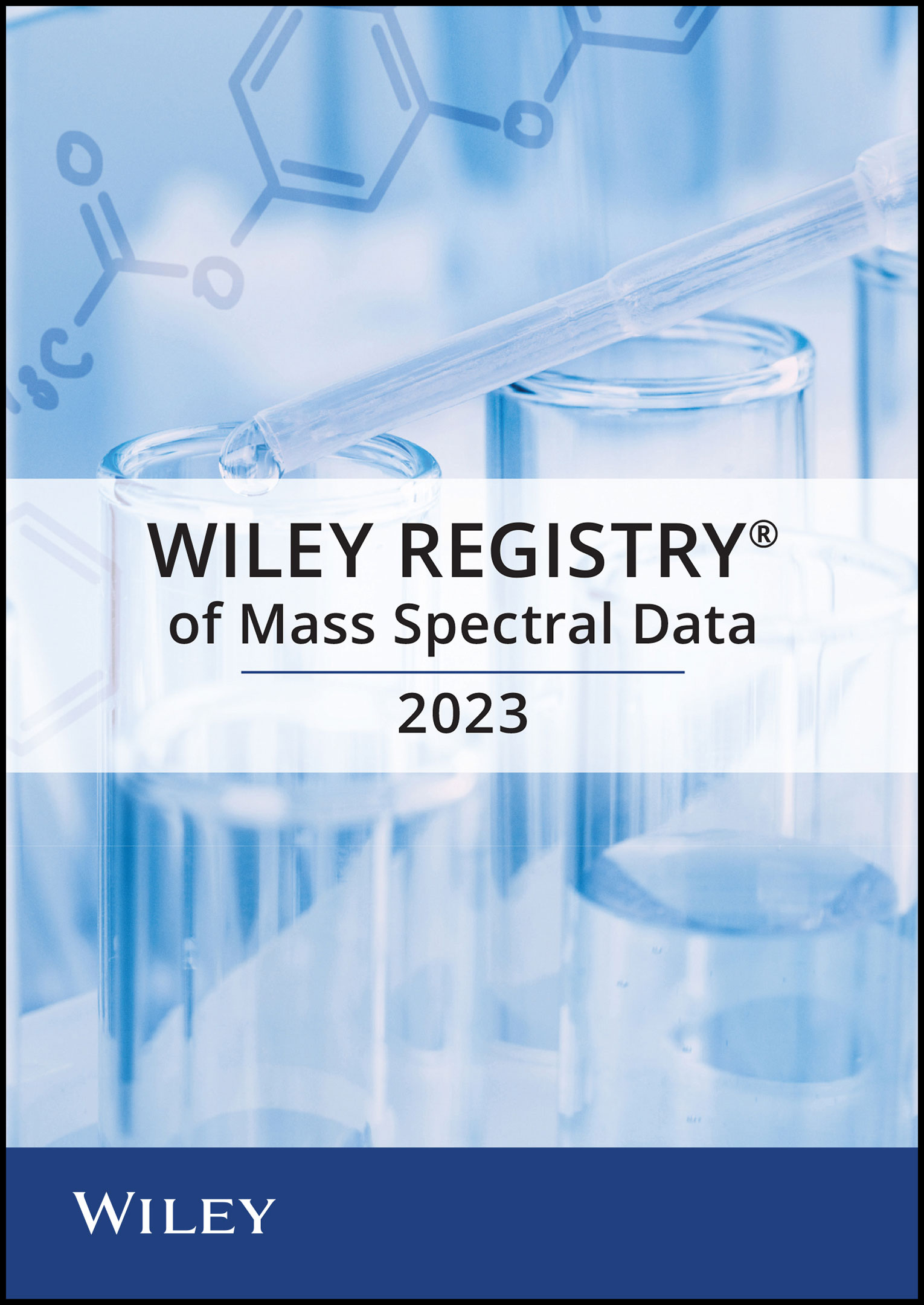Überblick
Vom Marktführer für Spektraldaten
Steigern Sie mit der GC-MS-Basisbibliothek für zuverlässige Spektralanalysen die Effizienz in Ihrem Labor
Das erprobte und bewährte Massenspektraldatenverzeichnis von Wiley erleichtert Laboren in aller Welt die Arbeit. Die Ausgabe dieser zentralen MS-Datenbank aus dem Jahr 2023 bietet Zugang zu mehr als 873.000 Spektren*, deckt noch mehr Fälle ab und gestaltet die Arbeitsabläufe noch effizienter.
Diese umfassende Bibliothek wurde für eine Vielzahl von Anwendungen entwickelt, vom unspezifischen GC-MS-Screening bis hin zu präzisen Massen-Workflows mit MS-TOF-Instrumenten. Sie garantiert Ihrem Labor selbst bei den anspruchsvollsten Anwendungen zuverlässige Ergebnisse bei Spektralsuchen.
Diese Spektrenbibliothek ist ein hilfreiches Instrument für jedes Labor, das GC-MS-Analysen durchführt, und gilt als „Laborstandard“, der dank unserer laufenden Bemühungen um die Bereitstellung relevanter Daten hoher Qualität ständig weiterentwickelt wird, um den kontinuierlich wachsenden Forschungsanforderungen von heute gerecht zu werden.
Umfangreiche Mischungsanalysen. |
Hervorragende Qualität und Genauigkeit. |
Nahtlose Integration. |
|
Große Bandbreite an Gemischen erhöht die Geschwindigkeit und Wahrscheinlichkeit der Erkennung bei gezielten und nicht unspezifischen Analysen. |
Daten werden von Experten zusammengestellt und geprüft. Verfügbare Metadaten (Eigenschaften, Struktur, DOI usw.) inbegriffen. |
Anbieterunabhängig und daher problemlos in vorhandene Workflows integrierbar. Unterstützte Gerätetypen anzeigen. |
Jetzt auch als KnowItAll-Abonnement erhältlich, das auch zwischen den größeren Ausgaben ständig Zugang zu aktuellen Daten gewährt
- Mit einem Abonnement können Sie auf neue, oft erfolgsentscheidende Daten sofort zugreifen, wenn sie ins Register von Wiley eingetragen werden.
- Kein Warten auf die nächste größere Ausgabe mehr – Ihr Labor profitiert sofort!
- Beim letzten Update kamen über 17.500+ neue Spektren hinzu. Insgesamt enthält die Datenbank nun schon mehr als 913.000+ Spektren. Erfahren Sie mehr.
Mit einem Abonnement haben Sie exklusiven Zugriff auf die neuesten Daten.
Anwendungen
Diese Sammlung ist eine außerordentlich zuverlässige, umfassende Informationsquelle für die Analyse, Identifizierung, Klassifizierung und Verifizierung von Gemischen in verschiedenen Anwendungsfällen der Massenspektrometrie:
- Umweltschutz
- Forensik
- Toxikologie
- Pharmazeutik
- Metabolomik
- Biotechnologie
- Lebensmittel und Kosmetik
- Verteidigung und Sicherheit
- Und vieles mehr
Vertrauenswürdige Daten aus einer vertrauenswürdigen Quelle
Wiley ist die maßgebliche Quelle für Spektraldaten. Unsere wohlbekannten Datenbanken werden gemäß strikter Protokolle verarbeitet, um eine möglichst hohe Qualität sicherzustellen. Die Qualifikationsverfahren beginnen bei der Datenerfassung und werden während des gesamten Datenbankentwicklungsprozesses fortgeführt. Von zuverlässigen Partnern stammende Daten werden sorgfältig überprüft, bevor sie in unsere Sammlungen aufgenommen werden.
Spezifikationen der Bibliothek
Das Wiley-Register ist jetzt auch als KnowItAll-Abonnement erhältlich, das auch zwischen den größeren Ausgaben ständig Zugang zu aktuellen Daten gewährt.
| Datentyp | Spektrennummer | |
| Wiley Registry 2023 | Abonnement für Wiley-Register (ab Juli 2025) |
|
| GCMS-Spektren | 873 300 | 913 300 |
| Durchsuchbare Strukturen | 841 100 | 881 100 |
| Individuelle Verbindungen | 741 000 | 771 400 |
| Geschätzte Kovats-Retentionsindizes | 738 400 | 772 600 |
Funktionen
Umfangreiches Spektrum an Verbindungen für (nicht) zielgerichtete Analysen im Rahmen von umfassenden Analysen.
Spektrendatensätze enthalten zusätzliche Informationen, die durchsuchbar sind, wie physikalische Eigenschaften, Strukturen und DOIs (sofern verfügbar), damit Suchergebnisse noch weiter verfeinert werden können.
Die Daten werden von internen und externen Experten von Wiley sorgfältig ausgewählt und überprüft, um zu gewährleisten, dass sie den Qualitätsstandards entsprechen und Sie sich auf die Ergebnisse verlassen können.
Die Spektren werden in separate Bibliotheken aufgeteilt, einschließlich einer Bibliothek für überschüssige Replikatspektren, was eine robuste Suche in verschiedenen Laborumgebungen ermöglicht. Mithilfe der einbezogenen Replikate können bestimmte Verbindungen in verschiedenen Laborumgebungen und Instrumenten einfacher abgerufen werden.
Kein Rätselraten hinsichtlich der Instrumentenkompatibilität mehr. Wiley Registry ist in den meisten gängigen Herstellerformaten verfügbar.
Was ist neu in dieser Ausgabe?
Stellen Sie sicher, dass Ihr Labor mit der neuesten Version dieser sich ständig weiterentwickelnden Sammlung auf dem neuesten Stand ist.
Machen Sie sich die Vorteile der Ausgabe 2023 zunutze:
- Ergänzung von über 50 000 individuellen Verbindungen mit über 56 000 Spektren.*
- Erweiterte Abdeckung von Weltpatenten und referierter Literatur, einschließlich DOIs zu den Originalartikeln. Daten werden auch von Partnerlabors bereitgestellt.
- Allen Spektren wurde ein Qualitätsindex zugewiesen. Daher können bei der Suche Spektren unterhalb eines Qualitätsindex-Schwellenwertes ausgeschlossen werden.
- Das Wiley Registry ist jetzt auch als KnowItAll-Abonnement erhältlich, das fortgesetzten Zugang zu neuen Daten zwischen den größeren Ausgaben gewährt.
Kompatibilität
- In den gängigsten Dateiformaten der Gerätehersteller verfügbar. Unterstützte Anbieter-Dateiformate anzeigen
- Auch als KnowItAll-Abonnement zur Verwendung mit der KnowItAll-Software von Wiley verfügbar, die mehrere Dateiformate der Gerätehersteller unterstützt
*Die aktuellen Inhalte sind derzeit nur im KnowItAll-Format verfügbar.
Bestellinformationen
|
Produktcode |
Produkt |
Format |
|
9781119736325 |
Wiley Registry für Massenspektrendaten 2023 |
USB |
|
978EALDB05697 |
Wiley Registry für Massenspektrendaten 2023 |
Digitaler Download |
| 9781394198740 |
Wiley Registry für Massenspektrendaten 2023 (Upgrade) |
USB |
|
978EALDB05703 |
Wiley Registry für Massenspektrendaten 2023 (Upgrade) |
Digitaler Download |
|
978EALDB05482 |
Wiley Registry für Massenspektrendaten (Jahresabonnement) |
KnowItAll-Abonnement |
|
978EALDB05499 |
Wiley Registry für Massenspektrendaten (Verlängerung des Jahresabonnements) |
KnowItAll-Abonnement |
